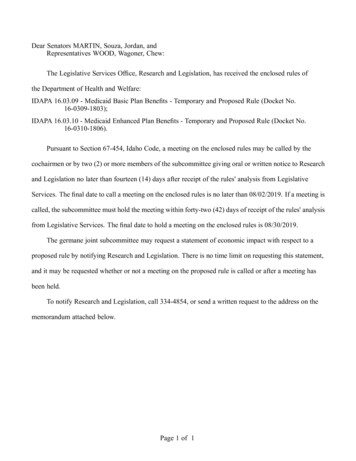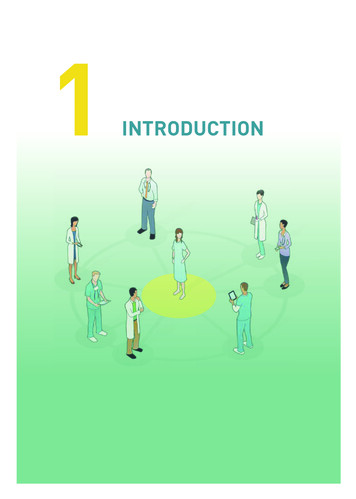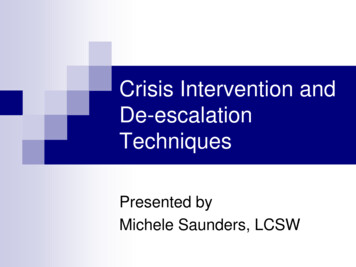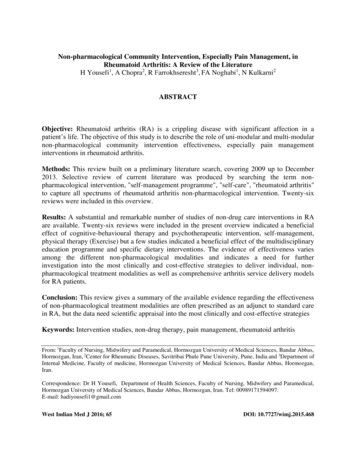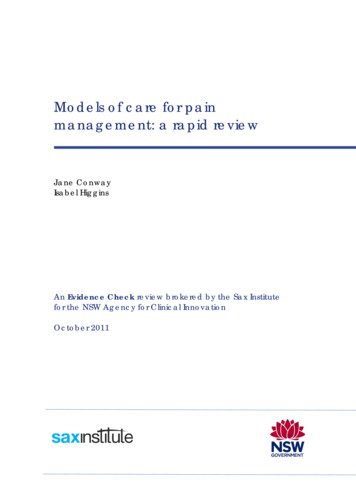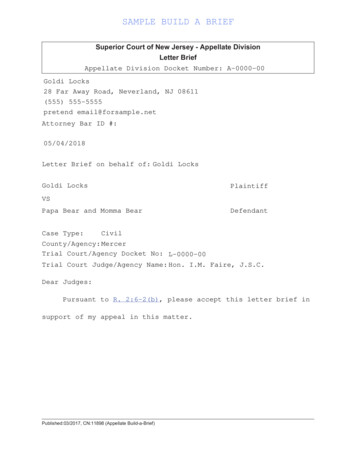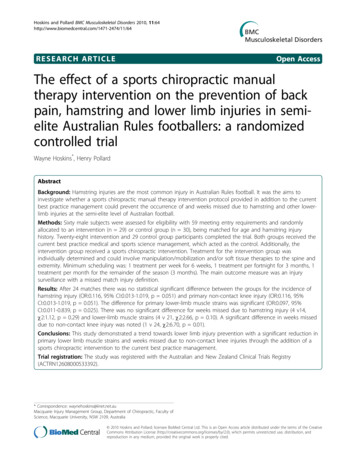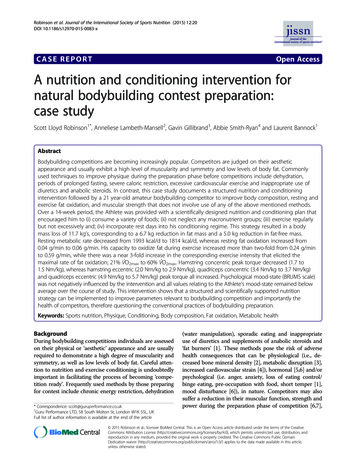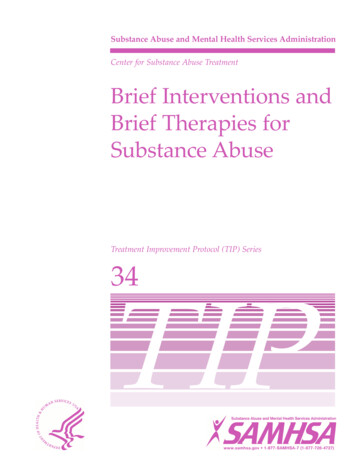
Transcription
Substance Abuse and Mental Health Services AdministrationCenter for Su stance A use TreatmentBrief Interventions ndBrief Ther pies forSubst nce Abuse34Treatment Improvement Protocol (TIP) Series
Brief Interventionsand BriefTherapiesFor SubstanceAbuseTreatment Improvement Protocol (TIP) Series34U.S. DEPARTMENT OF HEALTH AND HUMAN SERVICESSubstance Abuse and Mental Health Services Administration1 Choke Cherry RoadRockville, MD 20857
AcknowledgmentsThis publication was prepared under contractnumber 270-95-0013 for the Substance Abuseand Mental Health Services Administration(SAMHSA), U.S. Department of Health andHuman Services (HHS). Sandra Clunies, M.S.,I.C.A.D.C., served as the Contracting Officer’sRepresentative.Electronic Access and Printed CopiesThis publication may be ordered for free fromSAMHSA’s Publications Ordering Web page athttp://store.samhsa.gov. Or, please callSAMHSA at 1-877-SAMHSA-7 (1-877-726-4727)(English and Español). The document can bedownloaded from the KAP Web site athttp://kap.samhsa.gov.DisclaimerThe opinions expressed herein are the views ofthe consensus panel members and do notnecessarily reflect the official position ofSAMHSA or HHS. No official support of orendorsement by SAMHSA or HHS for theseopinions or for the instruments or resourcesdescribed are intended or should be inferred.The guidelines presented should not beconsidered substitutes for individualized clientcare and treatment decisions.Recommended CitationCenter for Substance Abuse Treatment. BriefInterventions and Brief Therapies for SubstanceAbuse. Treatment Improvement Protocol (TIP)Series, No. 34. HHS Publication No. (SMA) 123952. Rockville, MD: Substance Abuse andMental Health Services Administration, 1999.Public Domain NoticeAll materials appearing in this volume exceptthose taken directly from copyrighted sourcesare in the public domain and may bereproduced or copied without permission fromSAMHSA or the authors. Citation of the sourceis appreciated. However, this publication maynot be reproduced or distributed for a feewithout the specific, written authorization of theOffice of Communications, SAMHSA, HHS.iiOriginating OfficeQuality Improvement and WorkforceDevelopment Branch, Division of ServicesImprovement, Center for Substance AbuseTreatment, Substance Abuse and Mental HealthServices Administration, 1 Choke Cherry Road,Rockville, MD 20857.HHS Publication No. (SMA) 12-3952First Printed 1999Revised 2002, 2003, 2004, 2007, 2009, 2011, and2012
ContentsWhat Is a TIP?. viiEditorial Advisory Board. ixConsensus Panel . xiForeword. xiiiExecutive Summary and Recommendations . xvSummary and Recommendations. xviChapter 1—Introduction to Brief Interventions and Therapies .1An Overview of Brief Interventions .3An Overview of Brief Therapies . 7The Demand for Brief Interventions and Therapies.8Barriers to Increasing the Use of Brief Treatments .10Evaluating Brief Interventions and Therapies .11Chapter 2—Brief Interventions in Substance Abuse Treatment .13Stages-of-Change Model .14Goals of Brief Intervention.16Components of Brief Interventions .18Brief Intervention Workbooks .24Essential Knowledge and Skills for Brief Interventions .25Brief Interventions in Substance Abuse Treatment Programs .27Brief Interventions Outside Substance Abuse Treatment Settings.28Research Findings .30Chapter 3—Brief Therapy in Substance Abuse Treatment.37Research Findings .38When To Use Brief Therapy .39Approaches to Brief Therapy .41Components of Effective Brief Therapy .41Therapist Characteristics.49iii
ContentsChapter 4—Brief Cognitive–Behavioral Therapy.51Behavioral Theory .51Behavioral Therapy Techniques Based on Classical Conditioning Models .53Behavioral Therapy Techniques Based on Operant Learning Models .55Cognitive Theory .61Cognitive Therapy .63Cognitive–Behavioral Theory.68Cognitive–Behavioral Therapy .77Chapter 5—Brief Strategic/Interactional Therapies .87Solution-Focused Therapy for Substance Abuse .88Compatibility of Strategic/Interactional Therapies and 12-Step Programs .89When To Use Strategic/Interactional Therapies .90Case Study .92Strategic/Interactional Therapies .99Chapter 6—Brief Humanistic and Existential Therapies .105Using Humanistic and Existential Therapies .106The Humanistic Approach to Therapy .109The Existential Approach to Therapy .117Chapter 7—Brief Psychodynamic Therapy .121Background .121Introduction to Brief Psychodynamic Therapy.122Psychodynamic Psychotherapy for Substance Abuse .123Psychodynamic Concepts Useful in Substance Abuse Treatment .128Transference. 131Models of Brief Psychodynamic Therapy .135Other Research . 140Chapter 8—Brief Family Therapy.143Appropriateness of Brief Family Therapy . 144Definitions of “Family” . 145Theoretical Approaches . 147Using Brief Family Therapies . 152Followup . 154Cultural Issues . 154Chapter 9—Time-Limited Group Therapy .157Appropriateness of Group Therapy .157Group Therapy Approaches . 158Theories of Group Therapy .160Use of Psychodrama Techniques in a Group Setting . 164Therapeutic Factors . 166Using Time-Limited Group Therapy .168iv
ContentsAppendix A—Bibliography.173Appendix B—Information and Training Resources .209General Brief Therapy . 209Cognitive–Behavioral Therapy .209Strategic/Interactional Therapies .210Humanistic and Existential Therapies .211Psychodynamic Therapy. 213Family Therapy . 213Group Therapy . 214Appendix C—Glossary .215Appendix D—Health Promotion Workbook .221Part 1: Summary of Health Habits.221Part 2: Types of Drinkers in the U.S. Population . 222Part 3: Consequences of Heavy Drinking .223Part 4: Reasons To Quit or Cut Down on Your Drinking .224Part 5: Drinking Agreement .225Part 6: Handling Risky Situations .227Appendix E—Resource Panel .229Appendix F—Field 2-92-103-13-23-33-43-54-1Substance Abuse Severity and Level of Care .4Goal of Brief Interventions According to Setting.6The Stages of Change .15Sample Objectives .16American Society of Addiction Medicine (ASAM) Patient Placement Criteria.18FRAMES .19Scripts for Brief Intervention.20Screening for Brief Interventions for Alcoholism .22Client Feedback and Plan of Action.23Talking About Change at Different Stages .24Steps in Active Listening .26Professionals Outside of Substance Abuse Treatment Who Can AdministerBrief Interventions .28Criteria for Longer Term Treatment .39Selected Criteria for Providing Brief Therapy .40Approaches to Brief Therapy .42Characteristics of All Brief Therapies .44Sample Battery of Brief Assessment Instruments .45Classical Conditioning and Operant Learning .52v
ic Assumptions of Behavioral Theories of Substance Abuse and Its Treatment . 53Advantages of Behavioral Theories in Treating Substance Abuse Disorders .54Functional Analysis . 56Teaching Stress Management . 60Programmed Therapy and Writing Therapy.61The Relationship Among Factors Maintaining Behavior in Behavioral andCognitive Models . 62Fifteen Common Cognitive Errors .63Characteristic Thinking of People With Substance Abuse Disorders .64Common Irrational Beliefs About Alcohol and Drugs With More Rational Alternatives .65Thoughts, Feelings, and Behaviors .66Introducing Cognitive Therapy: A Sample Script . 67Common Elements of Brief Cognitive Behavioral Therapies.69Attributional Styles . 70Relapse Prevention Model Based on Self-Efficacy Theory .73Taxonomy of High-Risk Situations Based on Marlatt’s OriginalCategorization System .75A Cognitive Behavioral Model of the Relapse Process .76Essential and Unique Elements of Cognitive Behavioral Interventions .78Intrapersonal and Interpersonal Skills Training Elements . 80Assertiveness Training . 80Types of Clients for Whom Outpatient CBT Is Generally Not Appropriate.85Deliberate and Random Exceptions to Substance Abuse Behaviors .89Strategic/Interactional Therapy in Practice: A Case Study .93A Case Study . 111Defense Mechanisms. 132Brief Psychodynamic Therapy .136
What Is a TIP?Treatment Improvement Protocols (TIPs)are developed by the Substance Abuseand Mental Health ServicesAdministration (SAMHSA) within the U.S.Department of Health and Human Services(HHS). Each TIP involves the development oftopic-specific best-practice guidelines for theprevention and treatment of substance use andmental disorders. TIPs draw on the experienceand knowledge of clinical, research, andadministrative experts of various forms oftreatment and prevention. TIPs are distributedto facilities and individuals across the country.Published TIPs can be accessed via the Internetat http://kap.samhsa.gov.Although each consensus-based TIP strivesto include an evidence base for the practices itrecommends, SAMHSA recognizes thatbehavioral health is continually evolving, andresearch frequently lags behind the innovationspioneered in the field. A major goal of each TIPis to convey "front-line" information quickly butresponsibly. If research supports a particularapproach, citations are provided.vii
Editorial Advisory BoardKaren Allen, Ph.D., R.N., C.A.R.N.Professor and ChairDepartment of NursingAndrews UniversityBerrien Springs, MichiganRichard L. Brown, M.D., M.P.H.Associate ProfessorDepartment of Family MedicineUniversity of Wisconsin School of MedicineMadison, WisconsinDorynne Czechowicz, M.D.Associate DirectorMedical/Professional AffairsTreatment Research BranchDivision of Clinical and Services ResearchNational Institute on Drug AbuseRockville, MarylandLinda S. Foley, M.A.Former DirectorProject for Addiction Counselor TrainingNational Association of State Alcohol andDrug Abuse DirectorsWashington, D.C.Wayde A. Glover, M.I.S., N.C.A.C. IIDirectorCommonwealth Addictions Consultants andTrainersRichmond, VirginiaPedro J. Greer, M.D.Assistant Dean for Homeless EducationUniversity of Miami School of MedicineMiami, FloridaThomas W. Hester, M.D.Former State DirectorSubstance Abuse ServicesDivision of Mental Health, MentalRetardation and Substance AbuseGeorgia Department of Human ResourcesAtlanta, GeorgiaJames G. (Gil) Hill, Ph.D.DirectorOffice of Substance AbuseAmerican Psychological AssociationWashington, D.C.Douglas B. Kamerow, M.D., M.P.H.DirectorOffice of the Forum for Quality andEffectiveness in Health CareAgency for Health Care Policy and ResearchRockville, MarylandStephen W. LongDirectorOffice of Policy AnalysisNational Institute on Alcohol Abuse andAlcoholismRockville, MarylandRichard A. Rawson, Ph.D.Executive DirectorMatrix Center and Matrix Institute onAddictionDeputy Director, UCLA Addiction MedicineServicesLos Angeles, Californiaix
Editorial Advisory BoardEllen A. Renz, Ph.D.Former Vice President of Clinical SystemsMEDCO Behavioral Care CorporationKamuela, HawaiiRichard K. Ries, M.D.Director and Associate ProfessorOutpatient Mental Health Services and DualDisorder ProgramsHarborview Medical CenterSeattle, WashingtonxSidney H. Schnoll, M.D., Ph.D.ChairmanDivision of Substance Abuse MedicineMedical College of VirginiaRichmond, Virginia
Consensus PanelChairKristen Lawton Barry, Ph.D.Associate Research ScientistAlcohol Research CenterUniversity of MichiganAnn Arbor, MichiganWorkgroup LeadersTerry Soo-Hoo, Ph.D.Clinic Director/Assistant ProfessorCounseling Psychology DepartmentUniversity of San FranciscoSan Francisco, CaliforniaPanelistsChristopher W. Dunn, Ph.D., M.A.C., C.D.C.Psychiatry and Behavioral ScienceUniversity of WashingtonSeattle, WashingtonJanice S. Bennett, M.S., C.S.A.C.Owner/ConsultantPacific Consulting and Training Services ofHawaiiHonolulu, HawaiiJerry P. Flanzer, D.S.W., L.C.S.W., C.A.C.DirectorRecovery and Family Treatment, Inc.Alexandria, VirginiaRobert L. Chapman, M.S.S.W., C.A.D.O.A.C.,C.R.P.S.Cumberland HeightsNashville, TennesseeStephen Gedo, Ph.D.Clinical PsychologistGaffney, South CarolinaJohn W. Herdman, Ph.D., C.A.D.A.C.PsychologistThe Encouragement PlaceLincoln, NebraskaEugene Herrington, Ph.D.Associate ProfessorDepartment of Counseling and PsychologicalServicesClark Atlanta UniversityAtlanta, GeorgiaFredrick Rotgers, Psy.D.DirectorProgram for Addictions Consultation andTreatmentCenter of Alcohol StudiesRutgers UniversityNew Brunswick, New JerseyFanny G. Nicholson, C.C.S.W., A.C.S.W.,N.C.A.C.I., C.S.A.E.Alcohol and Drug SpecialistOconaluftee Job CorpsCherokee, North CarolinaMary Alice Orito, C.S.W., C.A.S.A.C., N.C.A.C.I.Evaluation SupervisorStuyvesant Square Outpatient Services forChemical DependencyNew York, New Yorkxi
Consensus PanelJerome J. Platt, Ph.D.Professor of Psychiatry and Public HealthDirector, Institute for Addictive DisordersHahnemann School of MedicineAllegheny University of the Health SciencesPhiladelphia, PennsylvaniaMarilyn Sawyer Sommers, Ph.D., R.N.ProfessorCollege of NursingUniversity of CincinnatiCincinnati, OhioJosé Luis Soria, M.A., L.C.D.C., I.C.A.D.C.,C.C.G.C., C.A.D.A.C.Clinical Deputy DirectorAliviane NO-AD, Inc.El Paso, TexasxiiAva H. Stanley, M.D.Somerset, New JerseyRobert S. Stephens, Ph.D.Associate ProfessorDepartment of PsychologyVirginia Polytechnic Institute and StateUniversityBlacksburg, Virginia
ForewordThe Treatment Improvement Protocol (TIP)they reach a consensus on best practices. Thisseries fulfills the Substance Abuse andpanel’s work is then reviewed and critiqued byMental Health Services Administration’sfield reviewers.The talent, dedication, and hard work that TIPs(SAMHSA’s) mission to improve prevention andtreatment of substance use and mental disorderspanelists and reviewers bring to this highlyby providing best practices guidance to clinicians,participatory process have helped bridge the gapprogram administrators, and payers. TIPs are thebetween the promise of research and the needs ofresult of careful consideration of all relevantpracticing clinicians and administrators to serve,clinical and health services research findings,in the most scientifically sound and effective ways,demonstration experience, and implementationpeople in need of behavioral health services. Werequirements. A panel of non-Federal clinicalare grateful to all who have joined with us toresearchers, clinicians, program administrators,contribute to advances in the behavioral healthand patient advocates debates and discusses theirfield.particular area of expertise untilPamela S. Hyde, J.D.AdministratorSubstance Abuse and Mental Health Services AdministrationPeter J. Delany, Ph.D., LCSW-C RADM, USPHSDirectorCenter for Substance Abuse TreatmentSubstance Abuse and Mental Health Services Administrationxiii
Executive Summary andRecommendationsThis Treatment Improvement Protocol(TIP) responds to an increasing body ofresearch literature that documents theeffectiveness of brief interventions and therapiesin both the mental health and substance abusetreatment fields. The general purpose of thisdocument is to link research to practice byproviding counselors and therapists in thesubstance abuse treatment field with up-to-dateinformation on the usefulness of theseinnovative and shorter forms of treatment forselected subpopulations of people withsubstance abuse disorders and those at risk ofdeveloping them. The TIP will also be useful forhealth care workers, social service providerswho work outside the substance abusetreatment field, people in the criminal justicesystem, and anyone else who may be called onto intervene with a person who has substanceabuse problems.Brief interventions and brief therapies havebecome increasingly important modalities in thetreatment of individuals across the substanceabuse continuum. The content of theinterventions and therapies will vary dependingon the substance used, the severity of problembeing addressed, and the desired outcome.Because brief interventions and therapies areless costly yet have proven effective in substanceabuse treatment, clinicians, clinical researchers,and policymakers have increasingly focused onthem as tools to fill the gap between primaryprevention efforts and more intensive treatmentfor persons with serious substance abusedisorders. However, studies have shown thatbrief interventions are effective for a range ofproblems, and the Consensus Panel believes thattheir selective use can greatly improve substanceabuse treatment by making them available to agreater number of people and by tailoring thelevel of treatment to the level of client need.Brief interventions can be used as a methodof providing more immediate attention to clientson waiti
Acknowledgments This publication was prepared under contract number 270-95-0013 for the Substance

